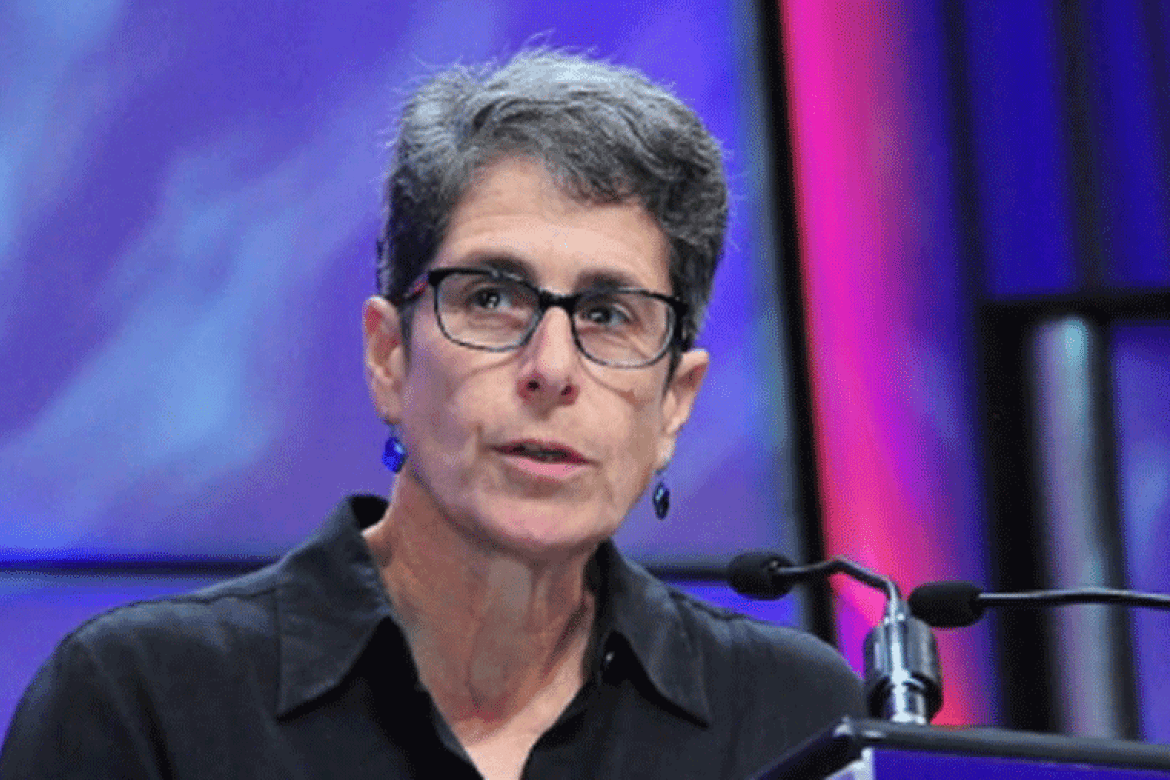A computer science legacy extends 70 years

Valerie Barr ’77, the first Jean E. Sammet Professor of Computer Science, shares with her benefactor an interdisciplinary vision of computing.
Story updated July 17, 2017, at 4:45 p.m.
By Sasha Nyary
In an act of extraordinary generosity not long before she died, Jean Sammet ’48 endowed a chair in computer science, the department’s first such funded position.
Sammet, who died in May 2017 at age 89, was one of the most important pioneers of modern computer science. Her accomplishments include inventing the programming language FORMAC and co-creating COBOL, a programming language that is still used today. Her donation was entirely in character with her lifelong commitment to Mount Holyoke College.
With the appointment of Valerie Barr ’77 to the Jean E. Sammet Endowed Chair in Computer Science, the legacy continues.
The lineage between Sammet and Barr is more than institutional. Like Sammet, Barr believes deeply that computing can be applied beyond STEM subjects and the social sciences to every field and across every department, including the humanities and the arts. Barr has been at the forefront of the interdisciplinary uses of computing for more than a decade, through both her educational focus and her scholarly research.
“Valerie, much like her endowed chair’s namesake, has been a pioneering force in computer science,” said Jon Western, dean of faculty and vice president for academic affairs. “She has helped to open the field to many women who otherwise wouldn't have access to it. She is an outstanding scholar, teacher and mentor, and we are very excited that she is returning to Mount Holyoke to share her experiences and her expertise.”
That experience includes serving as the chair of Union College’s computer science department and the director of interdisciplinary programs. Barr has also been a program director in the National Science Foundation Division of Undergraduate Education and the chair of the Association for Computing Machinery (ACM) Council on Women in Computing (ACM-W). In another connection between the two, Sammet was ACM’s first female president.
“Valerie has been an integral part of the current history of computer science and, in particular, of academic computer science,” said Margaret Robinson, Julia and Sarah Ann Adams Professor of Mathematics and the outgoing chair of computer science: With this appointment, Barr also becomes the new chair of the department.
“What is most striking is her belief that it is a discipline that can be integrated in various ways into a broad range of the liberal arts curriculum,” Robinson said. “Such a vision, not to mention its ability to convince others, can result only from a deep understanding of the many vocabularies that various liberal arts disciplines use to define themselves. We cannot emphasize enough the intellectual quality that Valerie brings to making this vision manifest.”
Computer science has been well-integrated into the higher ed curriculum of curriculum of STEM subjects, but Barr also wants to bring it together with the humanities and social sciences.
“My goal is for every student to see how computing is integrated in their own field," Barr said. "Even if they don’t learn how to program, I want them to see the relevance.”
The challenge for 21st-century liberal arts, she said, is to get computer science students to study the humanities, such as English and history, and to see the extraordinary possibilities for bringing their computing skills to problem-solving.
“There’s no better place to work on that than at Mount Holyoke and as the Jean Sammet Chair, because interdisciplinarity was something Jean was very passionate about,” she said.
Sammet taught a course at Mount Holyoke in the early 1970s that focused on using computing in the humanities and social sciences, an approach that was decades ahead of her time, Barr noted.
The College’s commitment to the Nexus concentration in data science is another reason for Barr’s excitement about the position. So is the extraordinary growth of the computer science department, which resonates particularly because Mount Holyoke is a women’s college.
“We really shortchange women if we don’t encourage them to learn about computer science, given that there are still so many societal forces acting against them wanting to come into these fields,” she said. “Knowing something about computing is increasingly important for everybody. We continue to see women cut out of the most cutting-edge jobs right now.”
Barr has long worked for women in technology and was recently given the Outstanding Contribution to ACM Award for broadening the impact of ACM-W, increasing its effectiveness in supporting women in computing worldwide and encouraging participation in the organization. She has been developing a new ACM Council on Diversity and Inclusion and is continuing with those efforts.
Diversity is an interest Barr has focused on in her research, which includes re-analyzing degree data such as race and ethnicity statistics, to better understand the dynamics of who studies computing. She also researches software testing, particularly as applied to natural-language generation systems and other artificial intelligence applications.
After receiving her B.A. in mathematics from Mount Holyoke, Barr received a master’s degree in computer science from New York University and then worked in the software development industry. After returning to graduate school, she earned a Ph.D. from Rutgers University and began her academic career at Hofstra University.
An avid road cyclist, Barr also plays viola and hopes to join the Mount Holyoke Symphony Orchestra. Her partner, Susan Yohn ’79, is a fourth-generation alumna. Their daughter, Camilla Yohn-Barr ’15, is Mount Holyoke’s first double-legacy student.
Join the legacy. Learn more.